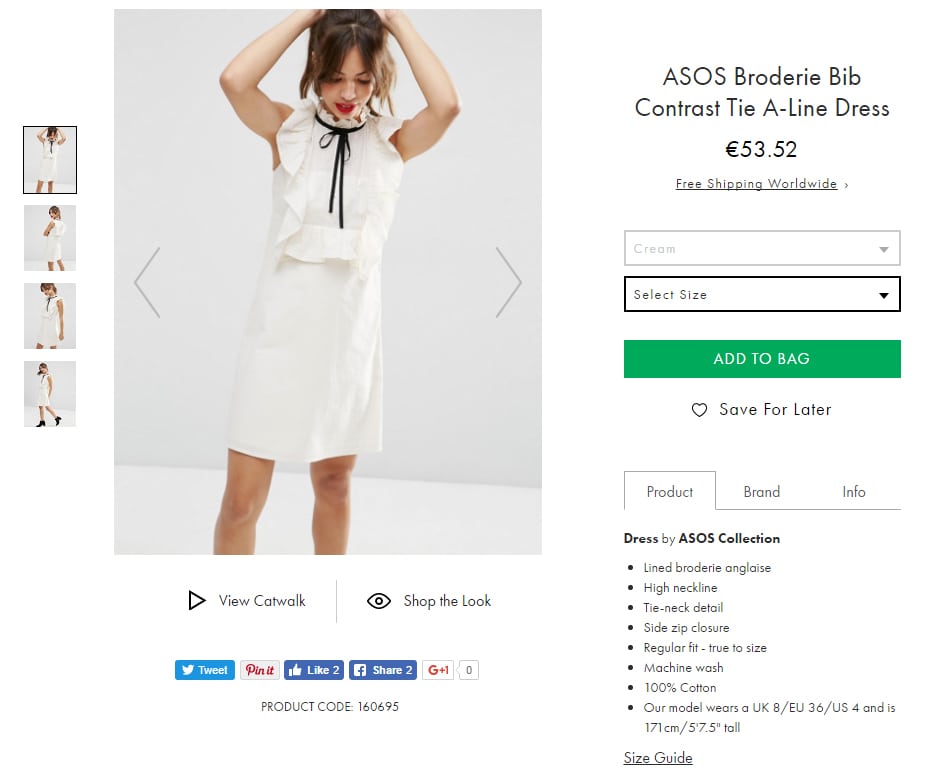If you find yourself having difficulties getting visitors to buy from you and are not selling as much as you would like to, chances are you are not addressing the online shopping pain points of your potential customers.
Online Shopping is undoubtedly on an upward trajectory. But, here’s the kicker: While 43% of sales are influenced by online, online sales account for only about 9% of retail. It’s still an impressive figure, but it also shows that there’s huge room for improvement. There are still groups of online shoppers who refuse to buy online – and your great products, competitive prices, or easy checkout have little to do with it.
So, what’s stopping them and what can you do?
1) Lack of choosing support
It’s a common perception that having a large assortment of products is key to online domination. However, psychology experts suggest that choosing between a large number of products can be physically exhausting. Offering too many choices without any choosing support is a source of great consumer frustration that you have to be mindful of. Once your shoppers are stressed out, there’s every chance that they won’t choose anything at all.
Solution:
It’s crucial to always consider the mind and purchase path of your customer. Many consumers, especially millennials, shop online not knowing what they want exactly, but they know they want it fast. It’s your chance to step up as a passionate and knowledgeable expert and help them discover products they’ll love and offers them ways to easily and intuitively pick the product that’s right for THEM.
Example: Sonos Speaker Selector.
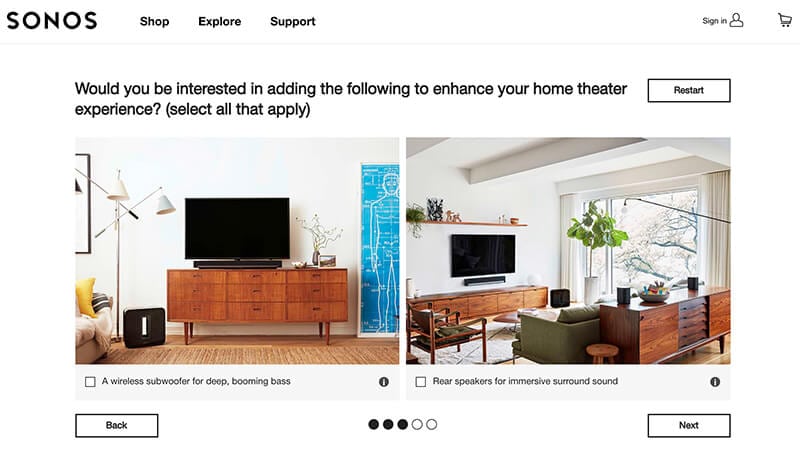
2) It’s #complicated…
While shoppers are attracted to complex-looking sites, they are increasingly frustrated by complicated site navigations, overwhelming options, and irrelevant details. Studies by Forrester Research estimate that approximately 50 percent of potential sales are lost because your visitors can’t find what they are looking for. Your visitors shouldn’t have to learn how you want them to navigate your site, it should come naturally.
Solution:
Is your navigation and site structure simple, yet informative? You can use heat map tools to understand what your shoppers are trying to do and reduce the number of clicks it takes them to find the products they’re looking for. Remove all the clutter that can distract your visitors and allow them to get a good feel for your company and the products you’re selling.

Effortless and intuitive navigation not only reduces shopper frustration, but it’s also a great confidence builder. Simply put, make them fall in love with you and your store at first sight.
3) Boring experience
It may come to you as a surprise, but the attention span of an online shopper isn’t any shorter than that of any other shopper on the high street. The key difference: Once online shoppers are distracted, uninspired, or bored, they’re gone.
Solution:
Create rich, enjoyable adventures that resonate with today’s impatient shoppers. Integrating approaches and technologies that make shopping more interactive and engaging, such as:
- gamification techniques
- interactive product guides
- social shopping
are great ways to sustain your shopper’s attention.
And, remember to always design your website with speed in mind. Customers are short on patience when shopping online. Google reports that 53% of mobile users abandon sites that take over 3 seconds to load.
Example: Bonobos found success by launching an online easter egg hunt campaign. The retailer hid male models dressed in their signature khaki pants on several partner sites. The first 50 people to find the images each day were awarded a $25 – $100 credit and free shipping. Bonobos was one of the first to marry gamification and shopping in a compelling way.

4) Missing product information
Consumers hate dealing with returns just as much as retailers or brand manufacturers do. They refuse to buy a product online if they cannot capture it mentally or cannot imagine how it will look once unpacked.
Not offering detailed product information that addresses the shopper’s questions about a product is a crucial mistake. It reduces your trustworthiness and triggers your visitors to leave your store in a hot second. According to a Forrester report, 45% of US customers are likely to abandon an online purchase if they can’t find a quick answer to their question.
Solution:
To avoid ticking online shoppers off, help them assess your product properly and give them all the information they need to feel comfortable purchasing your product. Use the same structure and spec labels for similar products to help your customers compare and decide. Remember: Consistency is key.
Example: Experience-based descriptions and Specs information of iPad Pro at apple.com
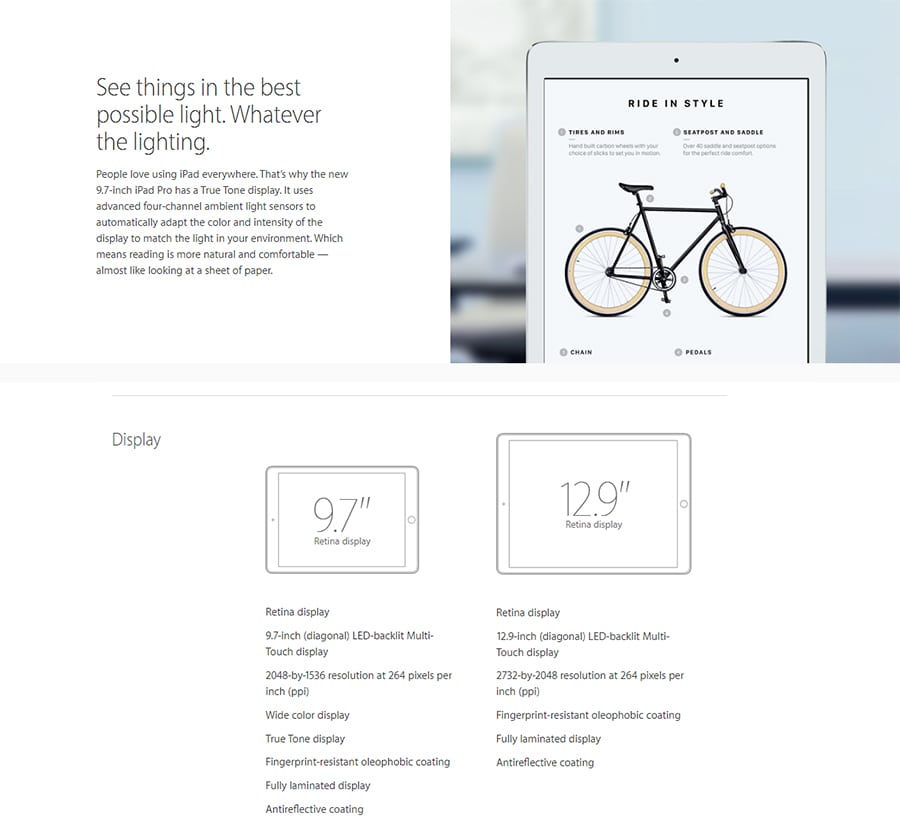
5) “Do not touch”
Humans are tactile beings and sensory experiences are a fundamental part of their shopping experience. Not being able to physically try out and touch a product is probably one of the biggest cons of online shopping. To make up for this disadvantage, online retailers have to go the extra mile and sell an experience, not just a product.
Solution:
Entice your shoppers with compelling product descriptions that highlight the benefits of each feature and appeal to their imagination. The best product descriptions go beyond telling shoppers what the product is and instead explain why it’s great for them. Describe how the product feels, how it helps them solve a problem, save time, or how it makes them happier. Complement the text with photos, graphics, and videos. Entertain, not just inform.
Example: Fashion juggernaut ASOS allows shoppers to watch unique ‘catwalk’ videos to better understand how long the garment is, how it is cut, how it fits, and how it moves – ultimately, helping shoppers make better purchase decisions.

6) Too many tech specs
When consumers are looking to buy a new product online, they want to be 100% confident with their purchase. Industries selling specialty items such as bikes or cameras offer hundreds of products that may appear similar to a novice, but in reality, are extremely different. Between all the features and specs that many specialty products come with, customers are likely to end up unhappy with their purchase without proper product knowledge.
Solution:
Every customer is different, so it’s important to understand and meet their individual requirements. By creating conversation and asking the right questions, you can guide them to the perfect product to fit their needs.
Example: Canon, a leading camera company offers a large variety of cameras on their website. Camera components like lens functionality, manual controls and sensors can make or break a customer’s purchase, so they created a visual product configurator to lead consumers to the products they’re looking for.
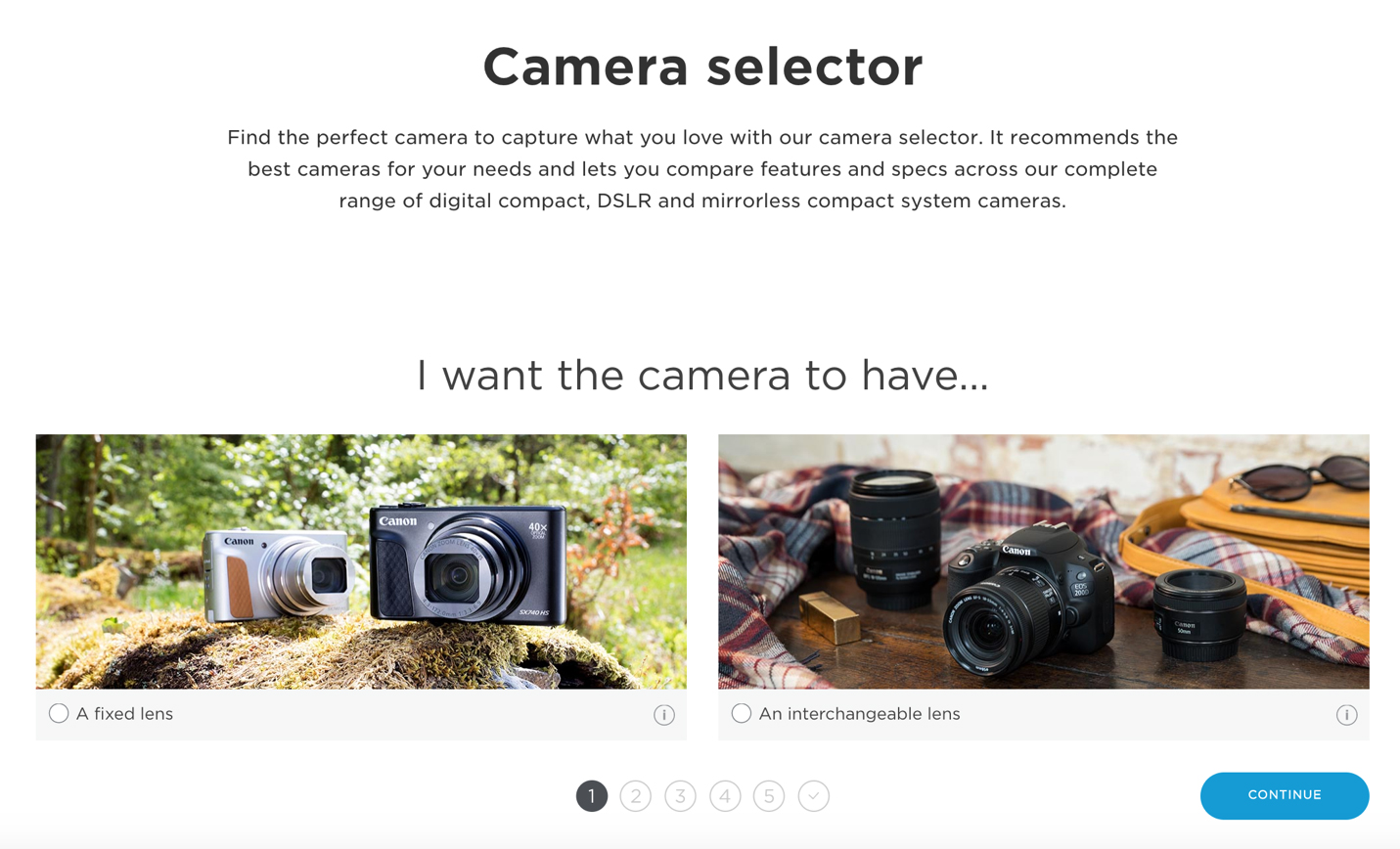
7) Model Vs. Reality
Have you ever ordered clothing online, tried it on and realized it looks completely different on you than it did on the model? We’ve all been there. Sizing charts may have accurate measurements, but they don’t take height, body type or weight into consideration. It’s hard for the average person to picture what a product looks like on their body when the model wearing the product is a tall, slender size 2.
Solution:
Include a variety of models of different shapes and sizes wearing each product. By including the height and weight specs of different body types, shoppers can have more of a realistic expectation of what a product will look like on their body.
Example: Lulus, a popular clothing website took product reviews to a whole new level. When a customer leaves a product review, there is an option to submit a product picture along with height and weight specs. This offers shoppers realistic expectations when making a purchase.
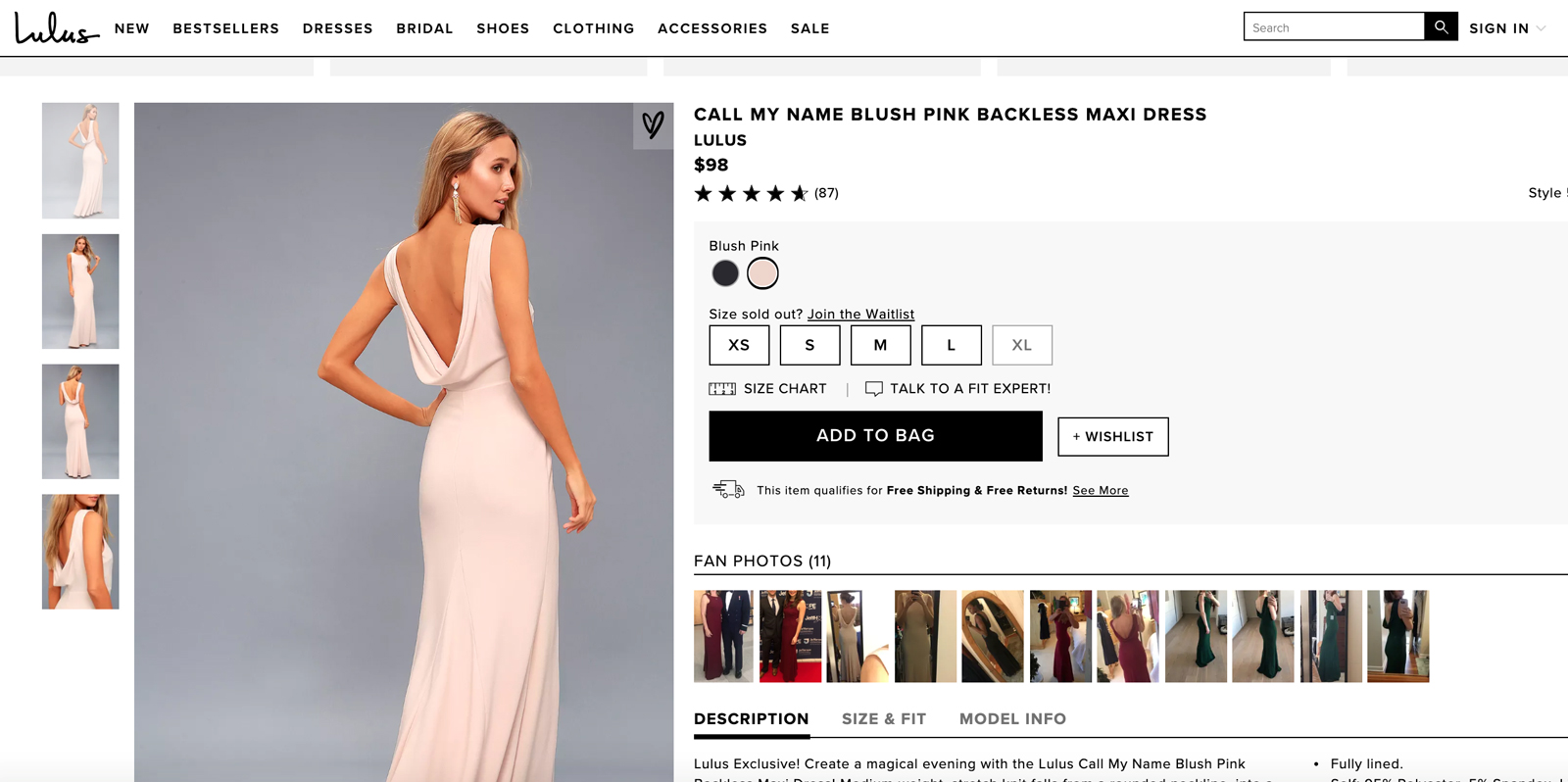

81% of customers say that they will buy from a business again if they were satisfied with the experience. So yes, going that extra mile for your customers and addressing their pain points will certainly pay off in one way or another. Conversions happen when you get the basics right and go beyond simply putting products out on display.
8) Payment Failures and Checkout Issues
One of the most frustrating aspects for online shoppers is encountering payment failures and complicated checkout processes. Issues such as declined transactions, slow processing, and confusing payment gateways can deter customers from completing their purchases.
Solution: E-commerce businesses should implement reliable and user-friendly payment options. Ensure that your payment gateway is equipped with SSL encryption to secure user data and reduce the risk of fraudulent transactions. Simplify the checkout process by reducing the number of steps and clearly displaying all costs, including shipping charges and taxes. Tools like Shopify offer integrated solutions to manage these aspects efficiently, enhancing the overall customer experience.
Example: Amazon has optimized its checkout process to be incredibly swift, often allowing users to complete purchases with just one click, thanks to saved payment methods and addresses.
9) Inadequate Customer Support and Service
Many online shoppers feel uncertain when they cannot easily access help or customer support. Issues such as long wait times, unhelpful responses, and lack of multiple communication channels can exacerbate customer dissatisfaction.
Solution: Invest in a robust customer support system that includes live chatbots, a detailed FAQ section, and a dedicated helpline. Make sure support is accessible through multiple platforms, including social media, to cater to all customer preferences. Regular training for customer service representatives can also ensure that shoppers receive the best possible advice and support.
Example: Many e-commerce platforms like Shopify encourage the use of integrated chatbot services that can handle common queries instantly and direct more complex issues to human agents.
10) Misleading Product Information and Quality Issues
Customers often complain about receiving products that do not match the descriptions or images seen online. Poor product quality and discrepancies in features can lead to high return rates and customer dissatisfaction.
Solution: Ensure that your product pages include accurate, detailed descriptions and high-quality images from multiple angles. Incorporate customer reviews and real-life images in your product descriptions to provide a clearer expectation. Regular quality checks for listed products can help maintain high standards and trust among consumers.
Example: Online retailers like Lulus encourage customers to upload their own photos and reviews, providing potential buyers with realistic expectations about the products.
11) Technical Glitches and Website Downtime
Technical issues such as website glitches, downtime, and slow loading times can significantly affect the user experience and deter potential customers.
Solution: Maintain a technically sound website by choosing a reliable hosting service and optimizing your website’s design for speed and efficiency. Regular updates and bug fixes are crucial to ensure smooth operation. Consider using a content delivery network (CDN) to improve site speed and handle high traffic efficiently.
Example: Major e-commerce sites invest in robust IT infrastructure to minimize downtime and ensure that shopping experiences are not disrupted, especially during high traffic periods like sales or holiday seasons.
12) Lack of Payment Options
Limited payment methods can turn away customers who do not find their preferred way to pay. Especially in regions like India, offering a wide range of payment methods including cash on delivery is crucial.
Solution: Expand your payment options to include credit cards, debit cards, digital wallets, and cash on delivery where applicable. This inclusivity can significantly enhance the checkout experience and cater to a broader audience.
Example: E-commerce giants like Amazon and Flipkart offer multiple payment methods, including EMI options and Pay on Delivery, accommodating a diverse customer base.
13) Unclear Return Policies and Difficult Return Processes
A complex or unclear return policy can deter customers from making a purchase. Shoppers are more likely to buy if they know they can return the product easily if it doesn’t meet their expectations.
Solution: Clearly outline your return policies on your website and ensure they are easy to find. Make the return process as simple as possible, perhaps offering free returns to increase trust and customer satisfaction.
Example: Many online fashion retailers offer hassle-free returns with pre-paid shipping labels to simplify the process for customers, thereby encouraging more purchases.

